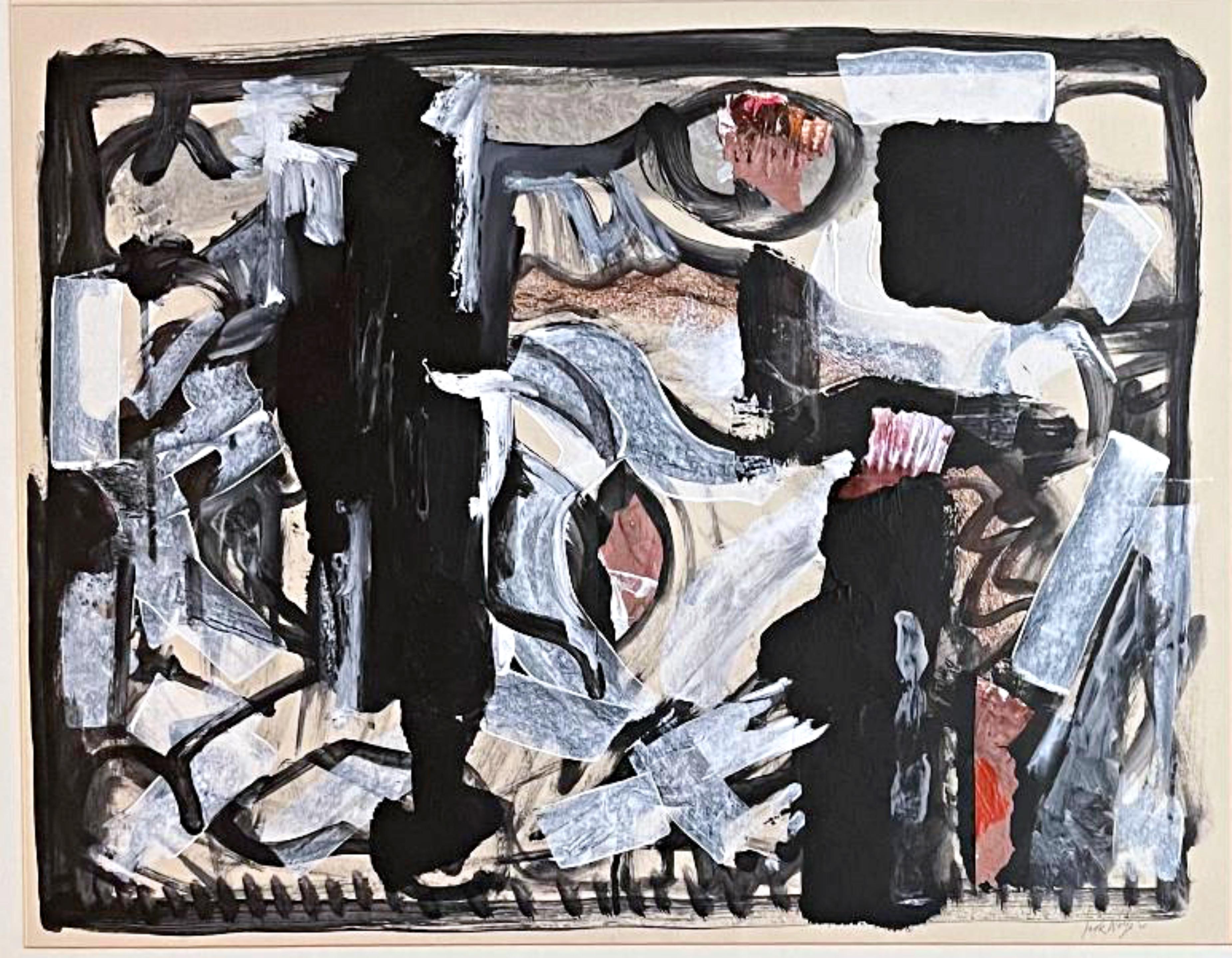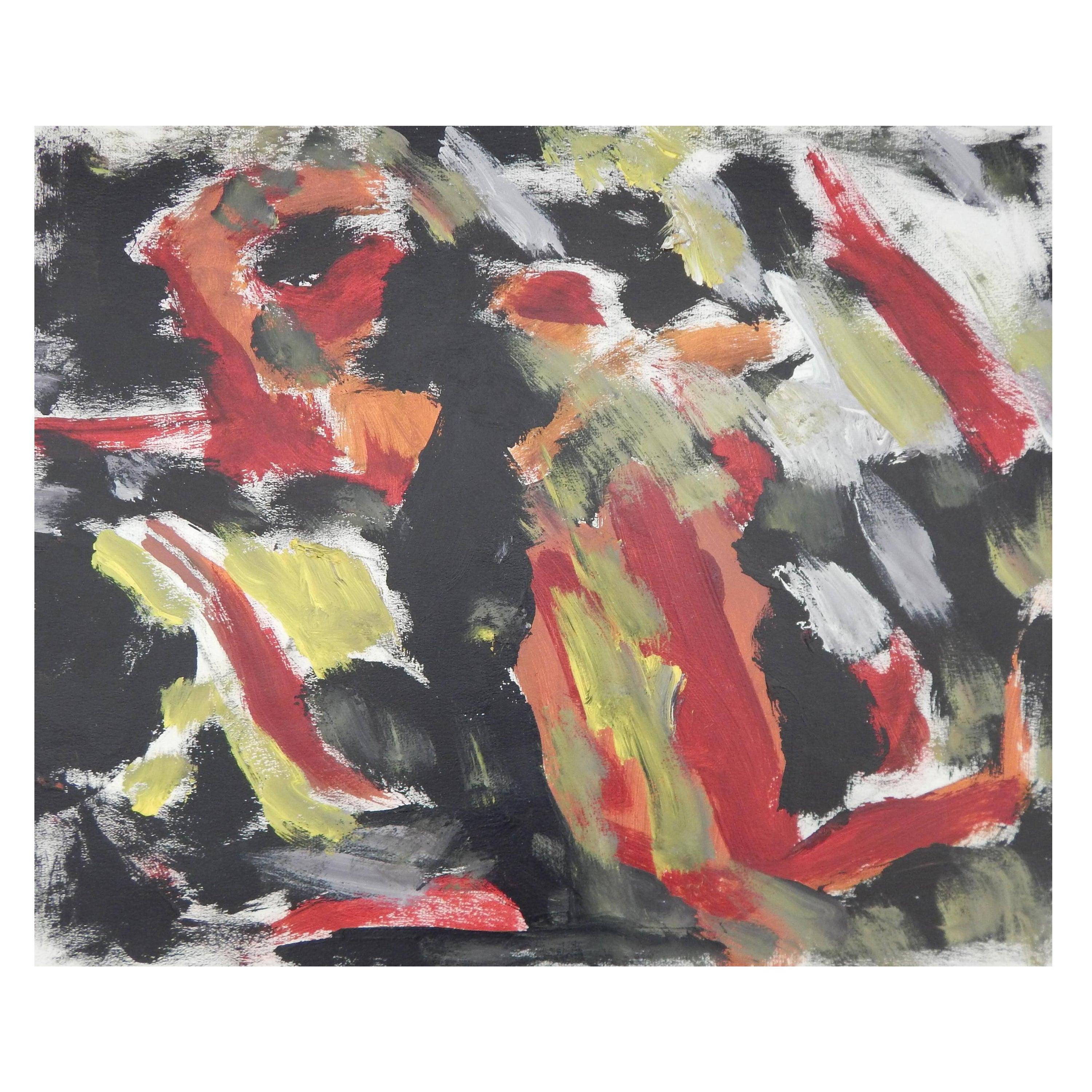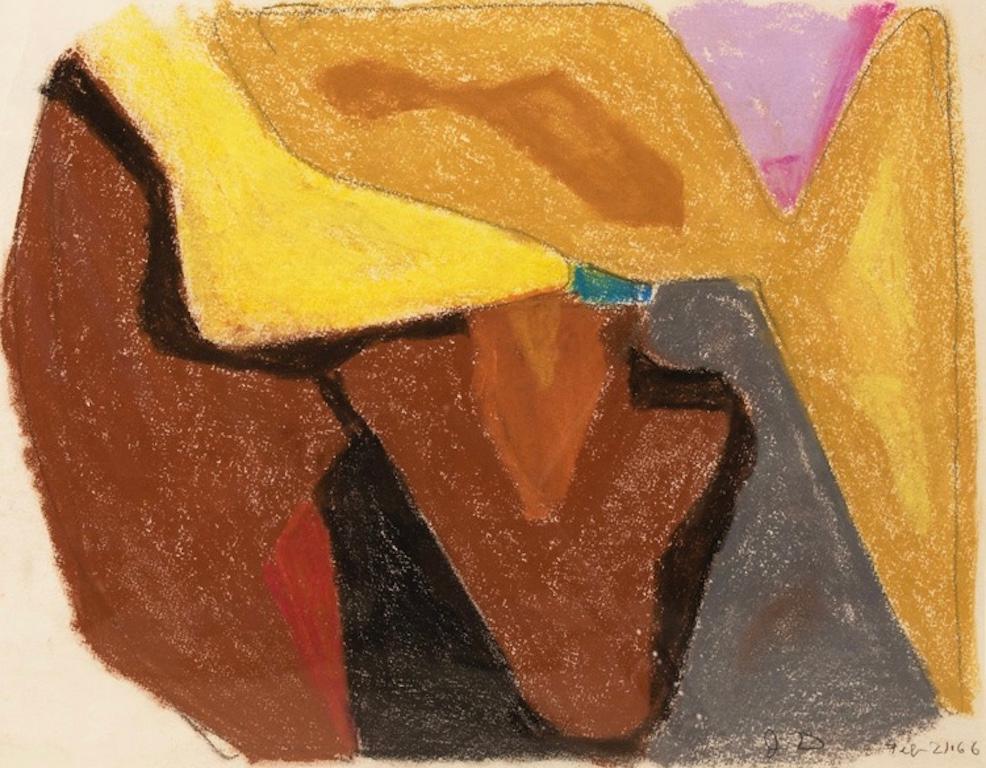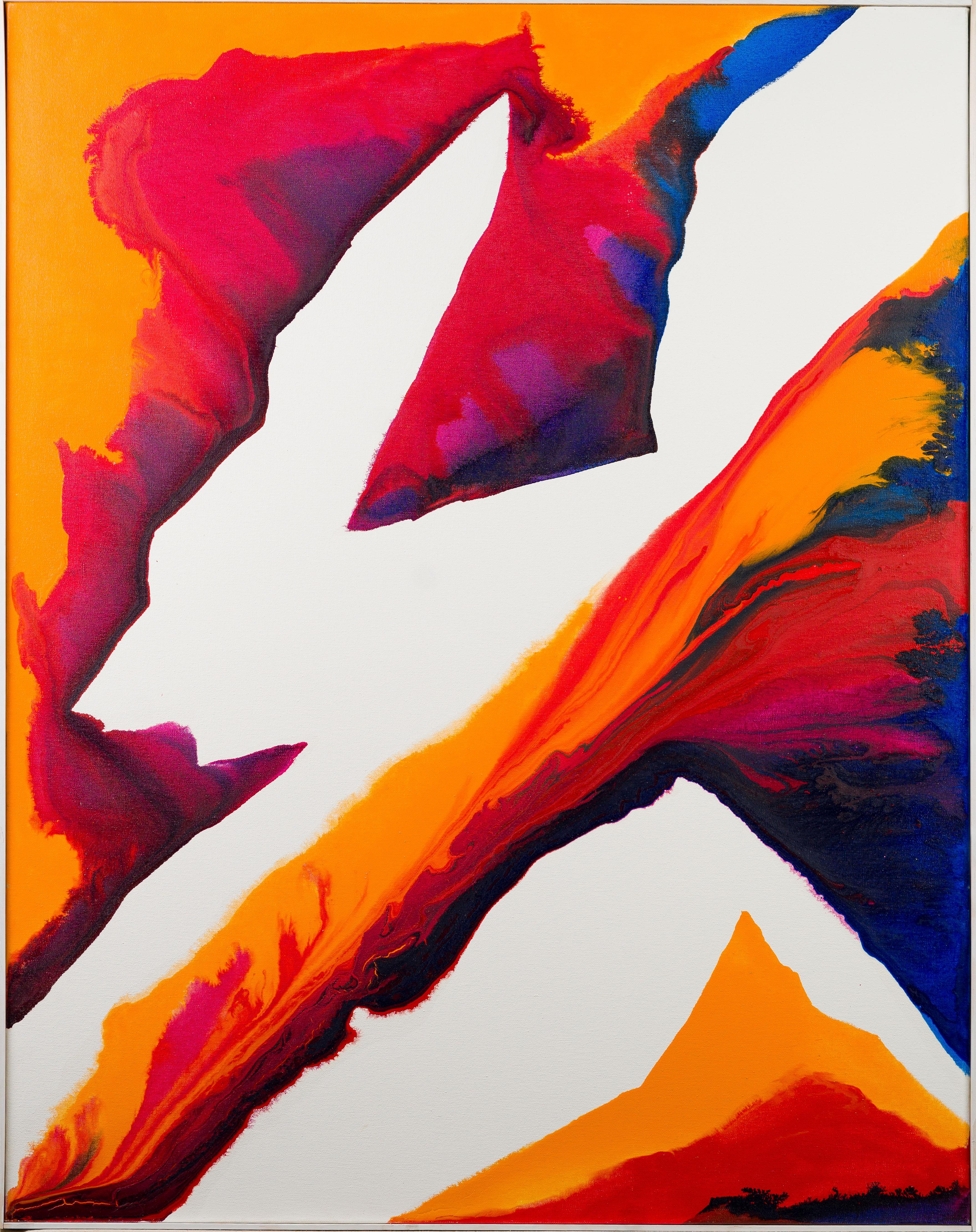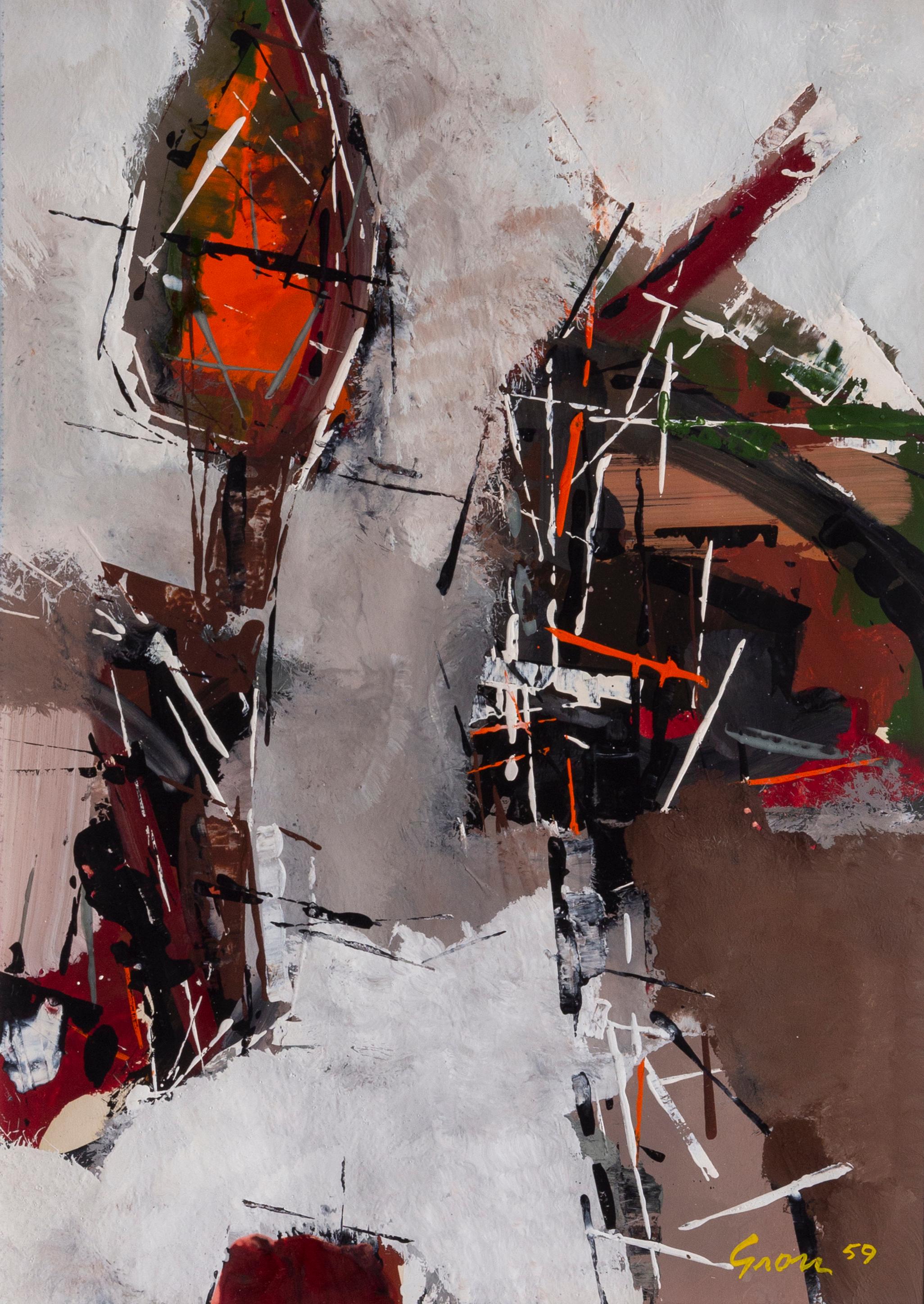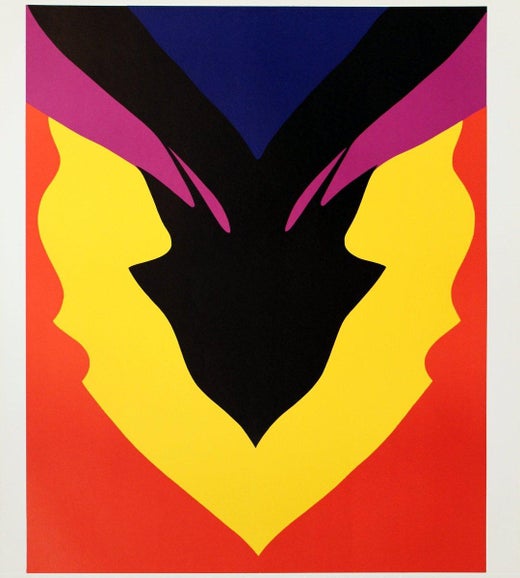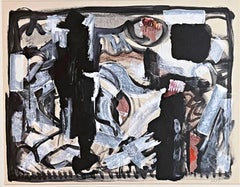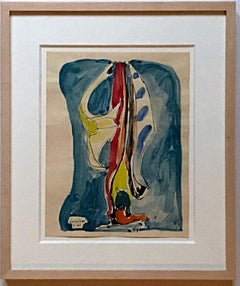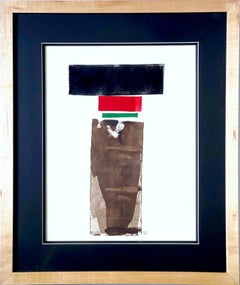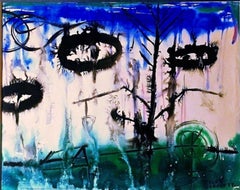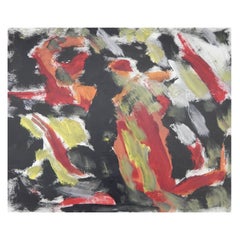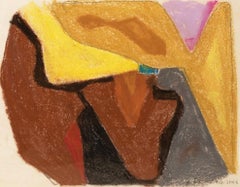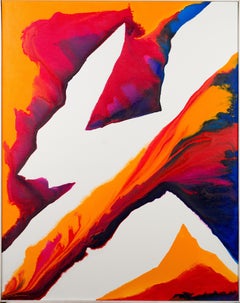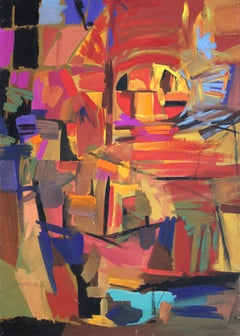Items Similar to Study #26, 1960s Gouache painting Signed Framed Pace & Hudson Gallery provenance
Want more images or videos?
Request additional images or videos from the seller
1 of 9
Jack YoungermanStudy #26, 1960s Gouache painting Signed Framed Pace & Hudson Gallery provenance1967
1967
$15,000
£11,320.09
€12,959.79
CA$21,154.97
A$23,225.52
CHF 12,116.80
MX$281,061.15
NOK 151,865.34
SEK 143,097.08
DKK 96,741.36
About the Item
Jack Youngerman
Untitled Study #26, 1967
Gouache painting on paper (with original JL Hudson and PACE Gallery labels)
Hand signed and dated '67 on the front; J.L. Hudson Gallery Label on Verso.
Unique Abstract Expressionist work on paper
Frame included
Framed
Measurements:
Framed:
15 inches by 15 inches by 1.5 inch
Artwork:
7.75 inches by 7.5 inches
Provenance
From the estate of Anne Markley Spivak
J. L. Hudson Gallery Label affixed to verso (back).
The J.L. Hudson Gallery, Detroit, Michigan
This 1967 unique, signed gouache painting by renowned abstract expressionist painter Jack Youngerman was acquired from the estate of Anne Markley Spivak. It is held in the original vintage metal frame with the original J.L. Hudson Gallery label, as well as the PACE gallery label on the verso
The artwork has been newly loated and framed in a museum quality white wood frame; the original labels from the original back board have been affixed to the back to preserve provenance.
Jack Youngerman Biography
Jack Youngerman was born in St. Louis, Missouri on March 25, 1926. He moved to Louisville, Kentucky in 1929 and studied at the University of Missouri, Columbia from 1944 to 1946 under a wartime navy training program. He graduated from the University of North Carolina Chapel Hill in 1947 and, that same year, he returned to Missouri to finish his Bachelor’s degree in Journalism before moving to Paris on a G.I. scholarship.
In Paris, Youngerman enrolled at the Ecole des Beaux-Arts, studying drawing with Jean Souverbie. He explored Paris, taking in the cathedrals, museums, and history in order to grasp a greater sense of art history. He also traveled to the Netherlands, Spain, Belgium, Italy, and Greece on fine art excursions.
In 1948, Youngerman became friends with Ellsworth Kelly, Eduardo Paolozzi, and Cesar – fellow students at Ecole des Beaux-Arts. He married Delphine Seyrig in 1950, and later that year he had his first group exhibition at Galerie Maeght in Paris. He visited the studios of Constantín Brancusi and Jean Arp and became heavily influenced by the organic forms present in their work. He also met artist Alexander Calder through his father-in-law, Henri Seyrig, and experimental filmmaker and artist, Robert Breer.
Interested in the resurgence of geometric abstraction, Youngerman found inspiration in Max Bill, August Herbin, and Richard Lohse. He also visited the Salon de Mai to closely examine the then current works of the School of Paris artists, especially Henri Matisse. The works of Henri de Toulouse-Lautrec, most notably his 19th century posters and collection of Japanese woodcuts, found their way into his mind, as well.
In 1951, his first solo exhibition was held at Galerie Arnaud in Paris. He met artist Francois Morellet and they became lifelong friends. Two years later, he visited the cave Lascaux (Dordogne), which had just recently been opened. The power of their animal imagery deeply impressed him.
While his father-in-law was the director of the French Institute of Archaeology in Beirut, he took the opportunity between 1954 and 1955 to visit, exploring the Middle East throughout Iraq, Syria, Turkey, and Jordan. Also in 1954, Youngerman had the opportunity to meet Peggy Guggenheim, visiting her collection in Venice. He worked with architect Michel Ecochard in Beirut and began his process of rendering organic forms in his works. Strong relationships between the positive and negative or the figure and its background began supporting his compositions, and these concerns began the primary focus within his style, continuing throughout his entire life.
His son, Duncan Pierre, was born in 1956, and that summer, notorious dealer Betty Parsons, visited his studio encouraging him to move to New York, which he did in December. He rented a home near the Battery at Coenties Slip, Manhattan, with his wife and son. His neighbors included Robert Indiana, Jasper Johns, Ellsworth Kelly, Fred Mitchell, and Robert Rauschenberg. In 1958, he debuted his first solo exhibition at Betty Parsons Gallery, which would be followed by six more. He also began exhibiting with the Carnegie Institute in Pittsburgh that same year. Many museum exhibitions would follow, including the Phillips Collection and the Corcoran in Washington, D.C. and the Museum of Modern Art and the Guggenheim in New York,
In 1972, Youngerman received the National Endowment for the Arts Award, exploring new media such as wood and polystyrene, permitting the development of new painted reliefs. He received the award again in 1984 and in 1985, and the Guggenheim held a 40-year retrospective of his works.
In 2000, Youngerman had his second son, Milo. In 2006, he was awarded a Fellowship from the Barnett and Annalee Newman Foundation, and since then, he has continued to create his life-size, organic sculpture and paintings on wood.
- Creator:Jack Youngerman (1926, American)
- Creation Year:1967
- Dimensions:Height: 15 in (38.1 cm)Width: 15 in (38.1 cm)Depth: 1.5 in (3.81 cm)
- Medium:
- Movement & Style:
- Period:
- Condition:Very good original condition; ships framed.
- Gallery Location:New York, NY
- Reference Number:1stDibs: LU1745216180372
Jack Youngerman
Jack Youngerman (1926–2020) is known for his powerful and graphic compositions that alternate between pure abstraction and highly stylized depictions of flowers or other elements from nature. Youngerman often synthesizes the best characteristics of Robert Motherwell and Ellsworth Kelly creating something highly original and confident. Youngerman's work always feels fresh, vibrant and optimistic. The artist has had a prolific career with major museum shows across the United States and internationally, including at the Guggenheim and MoMA.
About the Seller
5.0
Platinum Seller
Premium sellers with a 4.7+ rating and 24-hour response times
Established in 2007
1stDibs seller since 2022
451 sales on 1stDibs
Typical response time: 2 hours
- ShippingRetrieving quote...Shipping from: New York, NY
- Return Policy
Authenticity Guarantee
In the unlikely event there’s an issue with an item’s authenticity, contact us within 1 year for a full refund. DetailsMoney-Back Guarantee
If your item is not as described, is damaged in transit, or does not arrive, contact us within 7 days for a full refund. Details24-Hour Cancellation
You have a 24-hour grace period in which to reconsider your purchase, with no questions asked.Vetted Professional Sellers
Our world-class sellers must adhere to strict standards for service and quality, maintaining the integrity of our listings.Price-Match Guarantee
If you find that a seller listed the same item for a lower price elsewhere, we’ll match it.Trusted Global Delivery
Our best-in-class carrier network provides specialized shipping options worldwide, including custom delivery.More From This Seller
View AllMid century Modern 1960s Abstract Expressionist painting, renowned artist Signed
Located in New York, NY
Jack Wolfe
Untitled, 1965
Acrylic and collage on board
Hand signed on the front
Frame included: held in original vintage frame with original gallery label
Unique
Provenance: Parker Street 470 Gallery, Boston, Mass (with label verso)
Excellent abstract expressionist mixed media work.
Measurements:
Image:
17" x 24"
Framed:
24" x 28" x 1"
From Wiki:
Jack Wolfe (14 January 1924 – 18 November 2007) was a 20th-century American painter most known for his abstract art, portraiture, and political paintings. Jack Wolfe was born in Omaha, Nebraska on January 14, 1924, to Blanche and Everett L. Wolfe. Soon after his birth, his family moved to Brockton, MA. At 18, Wolfe had an interest in commercial illustration, which he pursued at the Rhode Island School of Design (RISD). However, upon matriculating at RISD in 1942, he developed an interest in fine art and painting inspired by an exhibition of modern French art. He described this change of direction, explaining that, "One day, for the first time, I saw an exhibition of modern French art. It was like being struck by lightning." He became particularly interested in the work of a number of European modernists, including Rouault, Cézanne, Braque, Modigliani, and Picasso.[1] Following his time at RISD, he pursued a Master’s in Fine Arts degree at the Museum of Fine Arts School in Boston, MA. At the Museum School, Wolfe studied under the renowned Expressionist Karl Zerbe, a German-born artist who was the Museum School's most influential and vital teacher until 1953.[2] After graduating from the Museum School, Wolfe was represented by the Margaret Brown Gallery in Boston, which also represented many other cutting edge Moderns that defied the more conservative tastes of New England collectors at the time, including György Kepes, Congur Metcalf, and Alexander Calder.[3]
Career and Museum Representation
Jack Wolfe's painting "Robin's Rock" 1962, 72" x 72"
Jack Wolfe's artwork received early recognition from a number of organizations and was consistently featured in influential exhibitions, including the 1955 Carnegie International at the Carnegie Institute in Pittsburgh, PA, the American Federation of Art's traveling exhibition New Talent in the USA in 1956-57, the Whitney Museum’s Young America exhibition in 1957,[4] the Boston Institute of Contemporary Art's Selection exhibition in 1957,[5] and both the Whitney Museum’s 1958 Annual exhibition and its Forty Artists Under Forty show in 1962-63.[6] In 1959, his widely acclaimed Portrait of Abraham Lincoln toured Europe in a show circulated by the Institute of Contemporary Art, Boston. In addition, his painting Crucifixion was chosen by the United States Information Agency to be exhibited across Europe, including being shown at the Salzburg Biennial in Austria in 1958.[7] Crucifixion was also exhibited at the Whitney Museum and subsequently displayed in the National Cathedral in Washington, DC, in 1958.[8] In 1966-67, his work was selected for Art for Embassies by the U.S. State Department.[9] He received the first annual Margaret Brown Memorial Award for high achievement by a New England Artist from the Institute of Contemporary Art, Boston, in 1958.[10]
With his future as one of the great artists of his time laid out neatly before him, Wolfe moved to New York in the early 1950s, which was then the postwar epicenter of the art world and in the midst of experiencing the first real revolution in American Art, now known as Abstract Expressionism.[11] However, almost immediately upon his arrival, he became disenfranchised with the overtly commercial nature of the art scene there, spurning fame and security in an unwillingness to bend his creative vision to the expectations of others.[12] After four short months, he left New York, returned to Massachusetts where he bought property in Stoughton, cleared the land, and built both his home and studio with his own two hands. He would go on to live and paint there, extensively exhibiting and garnering constant critical acclaim.[13]
Wolfe became one of the earliest artists championed by the deCordova Museum in Lincoln, MA and the Institute of Contemporary Art in Boston. He was awarded a traveling scholarship in 1958,[6] which allowed him to set up studio in San Miguel de Allende, Mexico and then in San Francisco, California.[14] Upon his return in 1959, the deCordova museum hosted Wolfe’s third solo exhibition, featuring work made during his time in California...
Category
1960s Abstract Expressionist Abstract Paintings
Materials
Mixed Media, Acrylic, Gouache, Permanent Marker
Ron Gorchov Mid Century Modern Abstract Expressionist painting on paper Signed
By Ron Gorchov
Located in New York, NY
Ron Gorchov
Untitled early 1960s Abstract Expressionist work, 1962
Ink and watercolor painting on paper
Signed and dated in black ink lower left recto
Frame included:
elegantly floa...
Category
1960s Abstract Expressionist Abstract Drawings and Watercolors
Materials
Ink, Watercolor
Lyman Kipp, Original Mid Century Modern Painting on paper signed Framed (unique)
Located in New York, NY
Lyman Kipp
Original Mid Century Modern Painting on paper, 1969
Acrylic on paper painting
Hand signed and dated by the artist on the front
F...
Category
1960s Minimalist Abstract Paintings
Materials
Acrylic
Untitled Abstract Expressionist painting on paper mid century modern art
By Rolph Scarlett
Located in New York, NY
Rolph Scarlett
Untitled Abstract Expressionist Painting, ca. 1960
Gouache, Ink, Watercolor on Paper . Hand signed, with original Jonas Aarons Gallery label
23 × 18 3/4 inches
Signed ...
Category
Mid-20th Century Abstract Expressionist Abstract Drawings and Watercolors
Materials
Watercolor, Gouache
Untitled Minimalist Painting, Signed and Inscribed to renowned curator Gene Baro
Located in New York, NY
Lyman Kipp
Untitled Minimalist Painting, 1964
Ink roller on paper
Hand signed and dated by Lyman Kipp on the front; inscribed on the back to Gene Baro (the distinguished critic and c...
Category
1960s Minimalist Abstract Drawings and Watercolors
Materials
Ink
Hans Hofmann at Andre Emmerich, scarce early 1970s Abstract Expressionist poster
By Hans Hofmann
Located in New York, NY
Hans Hofmann
Hans Hofmann at Andre Emmerich Gallery Poster, 1973
Offset lithograph poster
Plate signed on the bottom right front
Frame Included (held in original vintage metal frame)...
Category
1970s Abstract Expressionist Abstract Prints
Materials
Lithograph, Offset
You May Also Like
Harold Christopher Davies Abstract Expressionist Oil on Paper, 1968
Located in Phoenix, AZ
Harold Christopher Davies (1891-1976) abstract painting.
Signed lower left
Rubber stamp on the back from Hoover Gallery, San Francisco
Initialed and dated on the back, 1968
Oil on pa...
Category
Mid-20th Century Abstract Paintings
Materials
Paint
"Untitled" Mid 20th Century American Abstract 1960s Color Field Abstraction
Located in New York, NY
"Untitled" Mid 20th Century American Abstract 1960s Color Field Abstraction
James Daugherty (1887 – 1974)
Untitled
12 ¼ x 15 ¼ inches
Initialed and dated February 21, 1966 lower ri...
Category
1960s Abstract Abstract Drawings and Watercolors
Materials
Paper, Pastel
Vintage American Modernist Abstract Color Stain Signed Mid Century Oil Painting
Located in Buffalo, NY
Antique American modernist abstract oil painting by Majorie Shaw Kubach. Oil on canvas. Framed in a minimal white wood frame.
Category
1950s Modern Abstract Paintings
Materials
Canvas, Oil
Abstraction 5. 1965, paper, gouache, 83, 5 x 59, 5 cm
Located in Riga, LV
Abstraction 5. 1965, paper, gouache, 83,5x59,5 cm
Gunars Klava (1933 – 1989)
Gunars Klava was born in 1933 in Priekule.
1953 - graduated from J. Rosenthal Art School
1964 - began t...
Category
1960s Abstract Expressionist Abstract Paintings
Materials
Paper, Gouache
Abstract Expressionist Gouache Painting by Sid Gross 1959
By Sidney Gross
Located in Long Island City, NY
An Abstract expressionist gouache painting by American artist, Sid Gross.
Date: 1959
Gouache on paper, signed and dated lower right
Image Size: 18.5 x 12 inches
Frame Size: 28 x 22 ...
Category
1950s Abstract Expressionist Abstract Drawings and Watercolors
Materials
Gouache
Abstraction. 1966, paper, gouache, 44 x 32 cm
Located in Riga, LV
Abstraction. 1966, paper, gouache, 44x32 cm
Gunars Klava (1933 – 1989)
Gunars Klava was born in 1933 in Priekule.
1953 - graduated from J. Rosenthal Art School
1964 - began to part...
Category
1960s Abstract Expressionist Abstract Paintings
Materials
Paper, Gouache
